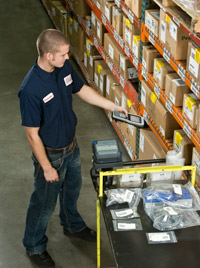MANUFACTURING DATA COLLECTION IN THE 21ST CENTURY
Achieving greater efficiencies with touchscreen systems
Many manufacturing companies still labor under the impression that bar coding is the solution to better factory floor operational management. The use of Bar Code Readers and Bar Code Printers have fallen off as the “go-to” technology for real-time methods of Work-In-Process tracking and production visibility.
The main reason? This technology does not provide the “control” aspect of production management. MES (Manufacturing Execution Systems) are now the favored choice for factory floor control. This one-stop solution provides real-time visibility and operator interaction that is simply not possible in a bar code reader.
Providing a touchscreen graphic user interface specifically designed for the factory floor enables greater efficiencies for implementing lean manufacturing processes. It allows for collecting process data for value stream mapping via metrics, data warehousing and data mining of the production process. In comparison, bar code readers are a one way push of accounting data that helps speed up the flow of financial information, but does little to lend understanding of real factory productivity.
“We can see the ease of use that a touchscreen system provides in the restaurant business,” said John Leibert, President, Factivity. “When servers have to take information quickly and pass it on to the kitchen, a touchscreen system easily enables this data to be entered for both the kitchen and the cash register. The restaurant business never went to bar code readers because it was too difficult and clumsy. But when touch screen technology was available, they quickly picked up on it. The same is possible for the factory floor.”
All the major Enterprise Resource Planning (ERP) vendors such as SAP, Oracle, JDE, QAD and Microsoft have outside partners to facilitate bar code data collection. They typically use RF readers from such well-known companies as Intermec, Symbol or Motorola. What can be problematic here, is that these software providers come from a data collection system approach to manufacturing – not a production process approach. When it comes to ramping up efficiency that will affect your bottom line, you need a system that provides you data on your process and more specifically, details as to where in your process you need to make improvements.
For example, you would likely not go to one of these ERP vendors to get a CAD system installed. Nor would you go to them to get Programmable Logic Controllers (PLCs) integrated into your floor assets. “It is no wonder why so many manufacturing companies get led down the bar code trail when what they really need is a system with an easy-to-use operator interface that can provide an important window into the factory and help analyze the process flow,” Leibert said.
Bar Coding, in the form of printed labels is, of course, another story. This method of inventory and part identification is here to stay. It is a good way to improve inventory accuracy and customer relationships, when managed properly. But having bar code printers does not require bar code (RF) readers on the factory floor.
Too often management gets fooled into believing that printers must have RF readers. That is not true with WIP tracking. Newer MES systems have moved the functionality of the Factory Floor User Interface to a point where the floor can become leaner for example:
- Paperwork for travelers, time sheets, drawings, set-up and quality paperwork can now be delivered in a “paperless” manner.
- Dynamic dispatching can help improve the flow of parts in a timely and organized fashion
- Bar code labels no longer have to be pre-printed and can be printed on demand as needed at the operation.
- WIP can be finitely scheduled with a software Production Scheduling system or APS to optimize the sequencing of the jobs.
- Alerts to production problems can be sent through email to smart phones for fast reaction.
- Data metrics with KPI’s focused on manufacturing performance can be warehoused for single or multiple factories for comparison of best practices to achieve World Class Manufacturing (WCM).
Ready to take your factory floor to the next level?
If you are looking to increase productivity and achieve lean manufacturing processes, we recommend you consider factory floor software that will tell you the whole story, and not be limited by bar code readers. FACTIVITY creates user friendly, easy-to-install, paperless software solutions that do just that.
FACTIVITY provides manufacturing companies with easy-to-use and easy-to-install MES. We provide activity tracking for your factory floor: from work force time tracking to overall equipment effectiveness. We provide the information systems to extend your ERP system to the factory floor. Our unique touchscreen interface can provide a reliable method to clock employees into the factory and track their time on each and every job while at the same time FACTIVITY can be the HMI to your machines and equipment providing real-time OEE and historical analysis to promote lean manufacturing in your production process.
For more information about FACTIVITY products and MES technology in general, visit our website at www.factivity.com
